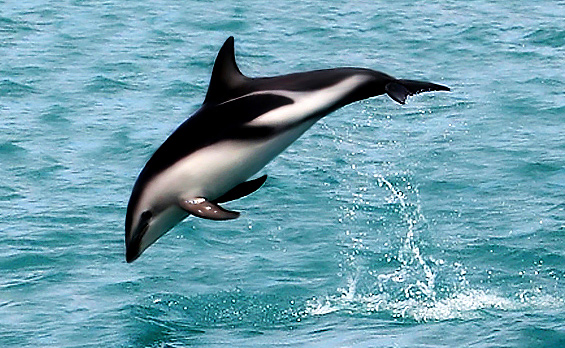The dusky dolphin (Lagenorhynchus obscurus) is a dolphin found in coastal waters in the Southern Hemisphere. Its specific epithet is Latin for “dark” or “dim”. It is very closely genetically related to the Pacific white-sided dolphin, but current scientific consensus holds they are distinct species. Charles Darwin also described what turned out to be this species as Delphinus fitzroyi from a specimen harpooned off Argentina in 1838. The dolphin’s range is patchy, with major populations around South America, southwestern Africa, New Zealand, and various oceanic islands, with some sightings around southern Australia and Tasmania. The dusky dolphin prefers cool currents and inshore waters, but can also be found offshore. It feeds on a variety of fish and squid species and has flexible hunting tactics. The dusky dolphin is known for its remarkable acrobatics, having a number ofaerial behaviors. The status of the dolphin is unknown, but it has been commonly caught in gill nets.
The dusky dolphin is small to medium in length compared with other species in the family. There is significant variation in size among the different population areas. The largest dusky dolphins have been encountered off the coast of Peru, where they are up to 210 cm (6 feet) in length and 100 kg (210 pounds) in mass. The size for dusky dolphins in New Zealand have been recorded to be a length range of 167–178 cm and a weight range of 69–78 kg for females and a length range of 165–175 cm and a weigh range of 70–85 kg for males.[13]
Almost no sexual dimorphism occurs in this species, although males have more curved dorsal fins with broader bases and greater surface areas.[13] The back of the dolphin is dark grey or black, and the dorsal finis distinctively two-toned; the leading edge matches the back in color, but the trailing edge is a much lighter greyish white. The dusky dolphins has a long, light-grey patch on its fore side leading to a short, dark-grey beak. The throat and belly are white,[14] and the beak and lower jaw are dark grey. Two blazes of white color run back on the body from the dorsal fin to the tail. Right between the white areas remains a characteristic thorn-shaped patch of dark color, by which the species can easily be recognized. Aside from that, dusky dolphins may be confused with other members of their genus when observed at sea. It can be distinguished from the common dolphin, which has a more prominent and longer beak and yellow flank markings.[15] The skull of a dusky dolphin has a longer and narrower rostrum than that of anhourglass dolphin or Peale’s dolphin of similar age and size.[16]
(From Wikipedia, June 2015)





